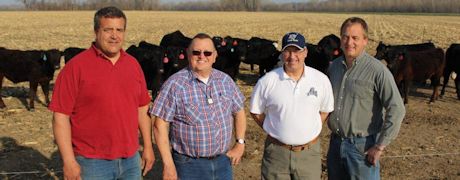
It was a harsh growing season for cover crops in Missouri. Late seeding coupled with lack of rain and early cold weather impacted growth. For many livestock producers wanting to glean the added forage off of cropland, the potential tonnage was just not there. Still, Forck Farms of Cole County pressed on, determined to see if cattle could maintain or even gain weight grazing cover crops and corn stover.
The Forcks, brothers Kelly and Keith, along with their father Mike "Pee Wee" Forck, are working with researchers at Lincoln University and the U.S. Natural Resources Conservation Service on a project that analyzes gains in steers and heifers using different cover crop mixes.
"It is truly a unique project in that it looks at cover crop grazing on a commercial scale," Todd Higgins, Lincoln University research agronomist says. "Our goal is to gain pounds per animal unit while trying to improve the soil in a no till environment," Kelly explains.
The plan
The grazing project incorporates roughly 400 acres of corn and soybean ground in the Missouri River bottoms. When the project first started in 2012, the Forcks seeded four different cover crop blends which included winter oats and turnips, rye and crimson clover, Austrian winter peas and oats, and wheat and barley.
The project flourished. "It was ideal cover crop growing conditions in 2012," says Higgins. "We were able to get the cover crops on and they received timely rains. We saw a lot of growth." The result--steers and heifers had up to 2-pounds-per-day gain on cover crops and corn stalks.
According to Higgins, the trial worked perfectly the first year. "We were so excited to see how this year's project would turn out," he says. "We really were riding on cloud nine." However, as so many farmers know, things can change in just a year.
Different year, different results
Last month, the cattle were just coming off of the cover crop and corn stover, so data has not been analyzed for the 2013-14 trials. However, Higgins says it will be like comparing "apples to crabapples." The cover crop growth was just not as robust as in the winter of 2012.
This year cover crops were seeded later. Then there was a lack of moisture. Once the crop emerged, cold temperatures set in. Still Kelly remains optimistic. "The cattle look to be in good condition," he says. "We will just need to wait on the data. Some may have gained, but I know they maintained (weight)."
At the end of the day, the Forcks want to be able to see just how many dollars can be generated off a unit of land resource during any given year. "We want to get the most out of our land while still keeping its integrity," Kelly adds.
Being able to look at data from a number of years and under a variety of growing conditions can only help cattle producers determine if grazing cover crops and corn stover is economically feasible. The Forcks will continue the project into 2015.
About the Author(s)
You May Also Like






